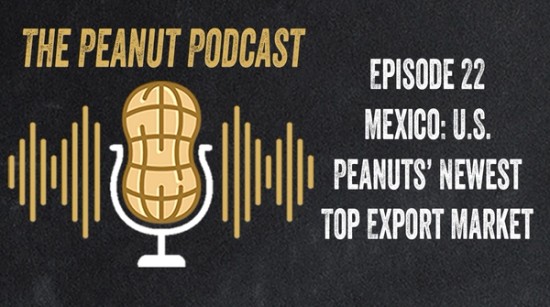Mexico is known for its rich cultural heritage, vibrant traditions and delicious cuisine. The country has also recently established itself as the top export market for U.S. peanuts. In this episode, we explore the work the American Peanut Council has done to nurture this market, the popularity and uses of the peanut in Mexico (and the potential for peanut butter) and what characteristics of peanuts matter to Mexican buyers and consumers. Guests are the American Peanut Council’s (APC) Peter Vlazakis, Mónica Moreno Arellano from Grupo PM, dietitian Esther Schiffman and Evelyn Lopez from Hormel. Read our recap below for quick a look at what we discussed in our episode.
We first spoke with Peter Vlazakis from the American Peanut Council. The APC’s mission is to support the long-term growth of the U.S. peanut industry. One of the ways they do that is by growing and maintaining export markets for U.S. peanuts and peanut products. After years of strong, steady growth, the APC’s work paid off when Mexico surpassed Canada to become the top destination for U.S. peanuts in 2021.
“Mexico is the top export destination for U.S. peanuts,” Peter said. “Last year, we sold about 150,000 metric tons of peanuts and peanut products to Mexico, valued at around $212 million. Mexico has emerged as our largest market relatively recently. It was behind Canada for many years and only in 2021 passed Canada as our largest export destination. But what we really see when we look at the Mexico market is unlimited potential for future growth. There are very few limiting factors that we think will keep peanut consumption from growing there. You see that product is eaten by everyone pretty much in Mexico. Almost 98% of consumers say they eat peanuts throughout the year, with I think nearly 70% saying they eat them weekly or more often, which is really impressive. And then on the growth side, they eat a lot of peanuts, but they have not developed a taste for peanut butter. So, if we can add that to their consumption patterns, really, things will skyrocket way more than they really are.”
We also spoke to Mónica Moreno Arellano from Grupo PM, which is the marketing agency the APC works with. As Peter said, peanuts are a very common food to eat in Mexico, which is why Grupo PM targets its marketing not only towards consumers but also the industry.
“We realized that we needed to have the industry on our side and make them aware of the advantages U.S. peanuts have…And by industry, I mean not only importers but snack and food manufacturers because, at the end, they are the ones that will be using peanuts to develop snacks or peanut butter,” Mónica said “Then, of course on the consumer side, we have two big targets. Those that consume peanuts, it's almost everyone and those that doesn't. And the ones that doesn't we focus a lot on peanut butter.”
Unlike in the U.S. where over 94% of households have a jar, only 10% of Mexican households contain a jar of peanut butter. Mónica went on to detail how one of the ways they are introducing peanut butter to consumers is by showing how it can be used in many different ways—from a smoothie at breakfast to ants on a log as a refueling snack for kids after school.
Next, we spoke to Ester Schiffman, a Mexican dietitian who works closely with Grupo PM. Esther uses her platform on radio, television and social media to encourage people to live longer and healthier lives through nutrition. According to Esther, people in Mexico love peanuts since they are a part of their culture and typical dishes. Esther says that people don’t realize how nutritious peanuts are, and that part of her job is to clear up myths and emphasize the benefits of peanuts, especially in relation to widespread health problems in Mexico. She even encourages people to work peanut butter into traditional Mexican dishes.
“It seems to me that more and more people have stopped seeing peanuts and peanut butter as just a simple snack and are starting to choose them for their health benefits,” Esther said. “But there is still a lot to talk about…And the advantage is that it’s a food that we love for its flavor and combines perfectly with Mexican gastronomy. So, I'm sure it will not be difficult to see it more and more every day in the Mexican daily tools.”
Lastly, we spoke to Evelyn Lopez, who works for Hormel, the maker of Skippy brand peanut butter, in Mexico. While peanut butter is a $2 billion industry in the U.S., peanut butter only makes up about 4% of the spreads category in Mexico. With honey, jams, chocolate spreads and more taking up the majority of the category, Skippy has had to get creative with how they market themselves. In addition to showing how peanut butter can be worked into traditional Mexican dishes and how it can be a great after-school snack for kids, Evelyn said they’ve started promoting peanut butter at races. They’ve included sample peanut butter in the race kits, and they’ve also set up a booth at the end of the race.
“When we started seeing that these races were going to be open again to all these runners that were really, really wishing to be back in the streets, we tried to get close to these organizations or these organizers to be part of their kits,” Evelyn said. “So, we started sampling peanut butter with them. We'll be at the end of the race with a boost of energy with a smoothie, with peanut butter, like a sachet of peanut butter. So, they took it after the run. And that's how we start talking to them.”
This recap of our episode only scratches the surface of the Mexican peanut export market. To learn more information, listen to the full episode here.
